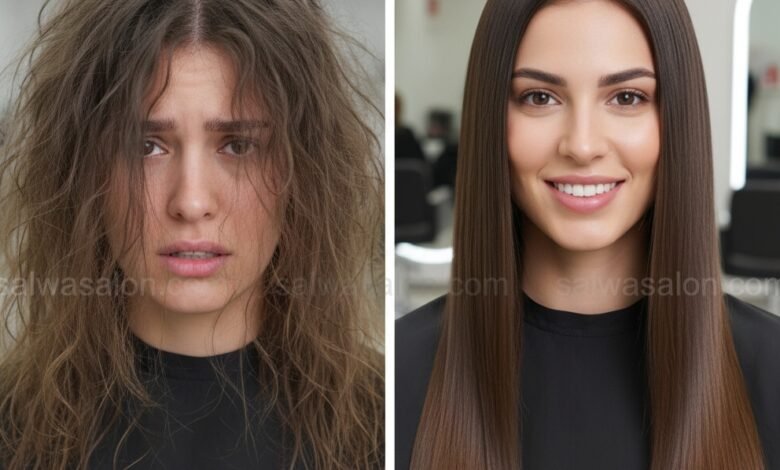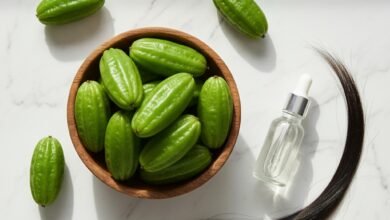Unpacking the Root Causes of Hair Damage Post-Smoothing & Straightening: Salwa Salon's Educational Guide
Ada beberapa penyebab kerusakan rambut akibat gagal smoothing straightening

Hair smoothing and straightening procedures have become a favorite solution for many individuals who desire straight, smooth, and manageable hair. The promise of its stunning transformation is often enticing, but behind it lies the potential for significant damage if not handled with adequate knowledge and expertise. Hair damage, ranging from extreme dryness, brittleness, to breakage, is the most common consequence of these procedures failing.
As beauty experts committed to in-depth education, we at Salwa Salon believe that a comprehensive understanding of the ‘why’ and ‘what’ behind every process is the main key to achieving optimal and sustainable results. This pillar article will thoroughly unpack the fundamental causes of hair damage post-smoothing and straightening, as well as how you can avoid it to maintain the health and beauty of your crowning glory.
Understanding the Mechanism of Damage: Why Does Hair Become Vulnerable?
Smoothing and straightening processes work by altering the natural structure of protein bonds (disulfide bonds) in the hair’s cortex. This is a powerful chemical process that requires high precision. When there is an error in any of the stages, the structural integrity of the hair can be permanently compromised.
- Improper Use of Heating Tools: Exceeding Hair’s Resistance Limits
Heating tools like flat irons are crucial components in the straightening process. However, their improper use is the most common cause of damage. Excessive heat or repeated exposure can cause denaturation of keratin protein – the primary protein composing hair. At temperatures above 180°C (depending on hair type), the cuticle (the outermost layer of hair) can lift, leading to a loss of internal moisture, evaporation of bound water, and even ‘bubble hair’ where air bubbles form inside the hair shaft. This weakens the hair, making it brittle and prone to breakage.
- Excessive Temperature: Not all hair has the same heat tolerance. Thin, color-treated, or previously damaged hair will be more sensitive to heat.
- Duration and Repetition: Clamping hair for too long or repeatedly processing the same section without sufficient breaks will accumulate heat damage.
- Without Heat Protection: Skipping the use of heat protectant products is a fatal mistake, as these products form a protective barrier that minimizes direct contact of heat with the hair cuticle.
- Inappropriate or Low-Quality Chemical Product Selection
The core of the smoothing process is the chemical formulation used. The wrong or low-quality product can trigger severe damage. Smoothing products generally contain reducing agents like Ammonium Thioglycolate or Sodium Hydroxide (for rebonding), followed by a neutralizer (oxidant) to lock in the new structure. Inappropriate products can mean:
- Aggressive Chemical Content: Products with too high pH or too strong concentrations of active ingredients can erode the hair’s natural protective layer and damage the cortex.
- Not Suitable for Hair Type: Hair that is already fragile, bleached, or color-treated requires a much gentler formula compared to healthy virgin hair. Using the same product for all hair types is a recipe for disaster.
- Lack of Additional Nutrients: High-quality professional products are usually enriched with conditioning agents, proteins, or moisturizers to minimize chemical side effects, something often absent in cheap or fake products.
- Incorrect Application Technique and Imprecise Process
Even with the best products and advanced tools, incorrect technique can derail the entire process and cause damage. The smoothing/straightening process is not just about applying cream and flat ironing; it’s a series of stages that require high precision:
- Poor Initial Hair Diagnosis: Skipping the analysis of hair condition (porosity, elasticity, chemical history) before the process.
- Uneven Product Application: Sections of hair with insufficient product will be less straight, while sections with too much product or exposed for too long will be over-processed and damaged.
- Incorrect Processing Time: Under-processing (insufficient time) results in hair that is not perfectly straight, while over-processing (excessive time) will make hair extremely fragile and breakable.
- Incomplete Rinsing: Chemical product residue left on the hair can continue to react and cause ongoing damage.
- Wrong Neutralization Process: The neutralization stage is crucial for locking in the new disulfide bonds. Errors at this stage can cause hair to revert to its curly state or even suffer severe damage.
- Fundamental Incompatibility Between Hair and Product/Procedure
Every individual has unique hair characteristics. Forcing a procedure or product without considering the specific condition of the hair is a fatal mistake. For example:
- Severely Damaged/Fragile Hair: Hair that has already suffered severe damage from repeated bleaching, intense coloring, or extreme heat may not be able to withstand the chemical stress of the smoothing process. The result is hair that breaks or becomes “gummy” (like chewing gum).
- Hair with Complex Chemical History: Hair that has been relaxed, permed, or bleached requires extra careful handling. Interactions between previous chemicals can lead to unexpected and damaging reactions.
Prevention Strategies: Avoiding Hair Damage Post-Smoothing & Straightening
To avoid the adverse effects of smoothing failures, you need to adopt a proactive approach and choose the right path from the outset.
- Choose an Experienced and Trusted Beauty Salon
This is the most crucial step. A trusted salon has:
- Certified Professional Hair Stylists: They understand hair anatomy, product chemistry, and correct application techniques.
- Premium Quality Products: Using formulations from reputable, tested, and safe brands.
- Advanced and Calibrated Heating Tools: Flat irons with accurate temperature settings and hair protection technology.
- In-depth Diagnosis & Consultation Protocols: A thorough assessment of your hair’s condition before starting the procedure.
- Conduct an In-depth Consultation with an Expert Hair Stylist
Never skip a consultation session. This is your opportunity to:
- Evaluate Hair Condition: Allow the hair stylist to assess your hair’s texture, porosity, elasticity, and chemical history.
- Understand Product & Technique Options: Discuss the most suitable product type (e.g., formula for color-treated vs. virgin hair), optimal flat iron temperature, and process duration.
- Set Realistic Expectations: Understand the achievable end results and potential risks.
- Good and Regular Post-Procedure Hair Care
The smoothing process leaves hair in a condition that requires extra care. Consistent care is essential to maintain results and prevent further damage:
- Use Sulfate-Free and pH-Balanced Shampoo & Conditioner: Sulfates can strip natural moisture and accelerate treatment fade. pH-balanced products help seal the cuticle.
- Apply Hair Mask or Deep Conditioner Regularly: Once a week with products rich in protein (if hair is fragile) or moisturizer (if dry) to restore nutrients and strength.
- Avoid Excessive Heat: Minimize the use of hot styling tools. If you must use them, always apply a heat protectant.
- Protect Hair from UV Rays and Chlorine: Wear a hat or use protective products when outdoors or swimming.
Responding to Damage: Tips for Caring for Already Damaged Hair
If your hair has already suffered damage post-smoothing, don’t panic. The following steps can help the recovery process:
- Switch to Very Gentle & Sulfate/Paraben-Free Shampoo and Conditioner: Choose formulations specifically designed for damaged or chemically processed hair.
- Minimize Heat Tool Usage: Let hair air dry naturally or use a hairdryer on the lowest heat setting. Avoid flat irons and curling irons.
- Restorative Hair Masks Regularly: Use masks rich in keratin, hydrolyzed proteins, natural oils (argan, coconut, jojoba), and moisturizing ingredients like hyaluronic acid. Do this 2-3 times a week.
- Hair Serum or Leave-in Conditioner: To provide an extra layer of protection and moisture throughout the day.
- Regular Hair Trims: Cutting off the most damaged parts of the hair (split ends) is key to preventing damage from spreading further up the hair shaft. Start with small trims and do them periodically.
- Professional Consultation: Do not hesitate to consult again with a professional hair stylist at Salwa Salon for recommendations on intensive treatments or salon treatments that can help revitalize your hair.
Salwa Bair Cares Conclusion
Smoothing and straightening procedures offer an attractive transformation, but their success largely depends on a deep understanding of the science behind them.
Hair damage post-procedure is not destiny, but rather a consequence of factors that can be avoided through the selection of the right salon, quality products, precise techniques, and consistent post-procedure care. By adopting this educational guide, you can not only enjoy beautiful straight hair but also ensure the optimal health and natural strength of your crowning glory are maintained. Salwa Salon is committed to being your trusted partner on your journey to healthy and stunning hair.






